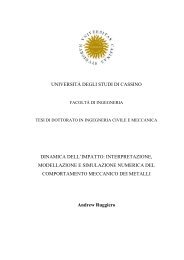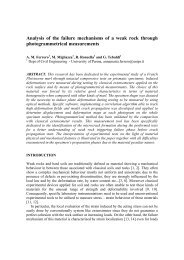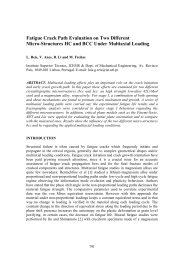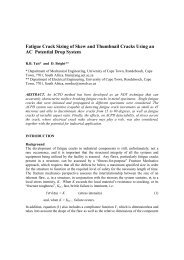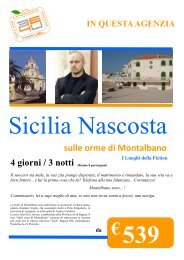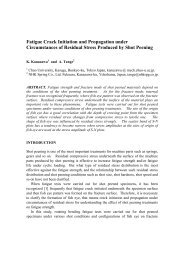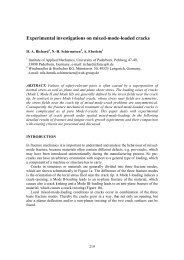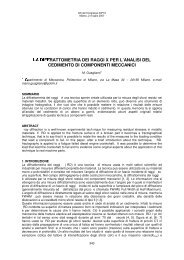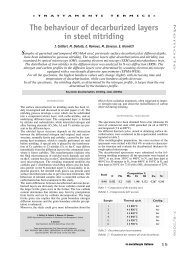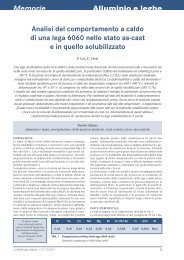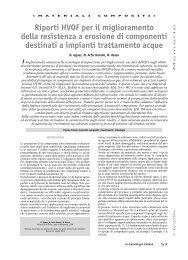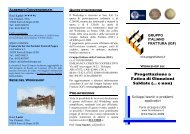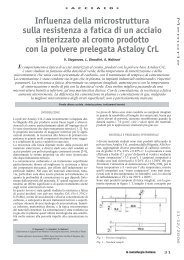a leap into the beginning of the metal - Gruppo Italiano Frattura
a leap into the beginning of the metal - Gruppo Italiano Frattura
a leap into the beginning of the metal - Gruppo Italiano Frattura
You also want an ePaper? Increase the reach of your titles
YUMPU automatically turns print PDFs into web optimized ePapers that Google loves.
Memorie >><br />
s<br />
Fig. 6<br />
Ancient nail (a) from <strong>the</strong> roman legionary at<br />
Inchtuthil (Wales, 83 a.C.) and its particular composite<br />
structure (b).<br />
Esempio di antico chiodo romano proveniente da<br />
Inchtuthil (83 a.C.).<br />
s<br />
Fig. 8<br />
Influence <strong>of</strong> annealing on work hardened<br />
copper. The pure copper recrystallization temperature<br />
is about 220°C.<br />
Influenza del processo di ricottura sulle proprietà<br />
di resistenza e duttilità del rame precedentemente<br />
incrudito.<br />
recrystallization, whose energy <strong>of</strong> activation can be overcome by<br />
<strong>the</strong> temperature field which can be reached during <strong>the</strong> Neolythic<br />
Age (Fig. 8). The recrystallization is a phenomenon <strong>of</strong> nucleation<br />
and growth <strong>of</strong> new grains which consume <strong>the</strong> previous deformed<br />
one, recreating s<strong>of</strong>t unstrained crystallites.<br />
The plastic deformation and <strong>the</strong> related phenomena and processes<br />
are at <strong>the</strong> basis <strong>of</strong> <strong>the</strong> working operation which follows under <strong>the</strong><br />
name <strong>of</strong> sphyrèlaton (σϕυρηλατον-worked by hammer), a technique<br />
typically applied in <strong>the</strong> first statuary art, but also for coating<br />
buildings and ships. This technique consists in <strong>the</strong> coating <strong>of</strong> a<br />
wood or marble core by a thin <strong>metal</strong> layer applied by hammering<br />
and fixed by rivets (Fig. 9) [11].<br />
Although <strong>the</strong> recrystallization takes place, <strong>the</strong> microstructure<br />
formed after <strong>the</strong> annealing goes on to be featured by <strong>the</strong> traces <strong>of</strong><br />
<strong>the</strong> induced plastic deformation. Actually, even if <strong>the</strong> hardening<br />
due to sliding and twinning deformation is nearly eliminated, <strong>the</strong><br />
orientation <strong>of</strong> <strong>the</strong> new generated grains are affected by rotations<br />
undergone by <strong>the</strong> deformed crystallites (Fig.10) [12,13,14].<br />
The crystallite rotate in <strong>the</strong> space and displace <strong>the</strong>mselves following<br />
peculiar orientation; this issue appears as particularly clear in<br />
Storia della <strong>metal</strong>lurgia<br />
s<br />
Fig. 7<br />
VCopper in <strong>the</strong> native state (SEM micrographs).<br />
Aspetto del rame nativo osservato mediante SEM.<br />
s<br />
Fig. 9<br />
Example <strong>of</strong> sphyrèlaton. Separate foils are applied<br />
on <strong>the</strong> mold (a), <strong>the</strong>n <strong>the</strong>y are hammer (b), until <strong>the</strong> mold are<br />
completely covered (c) foils are fixed by rivet (d); bull found in<br />
Tell el Obeid (III millennio b.C.) realized by sphyrèlaton.<br />
Stadi del processo di realizzazione di uno sphyrèlaton<br />
(σϕυρηλατον-lavorato al martello). (a) Fogli separati vengono<br />
preparati per essere avvolti su un’anima in legno o in pietra (b) e<br />
successivamente vengono fatti aderire attraverso martellatura.<br />
(c) Le lamine di copertura vengono ribattute sino a che l’anima<br />
viene completamente rivestita (d) e successivamente vengono<br />
fissate attraverso l’applicazione dei rivetti.<br />
la <strong>metal</strong>lurgia italiana >> aprile 2008 11



